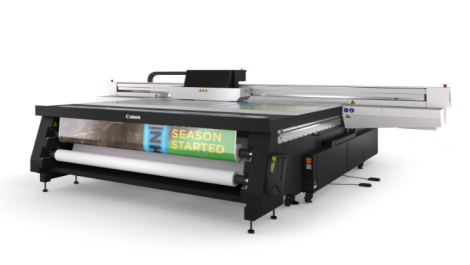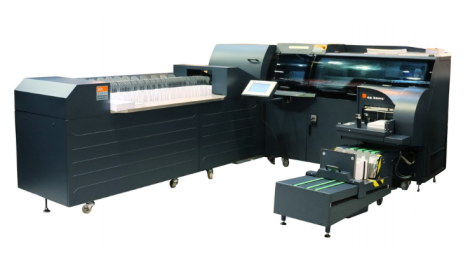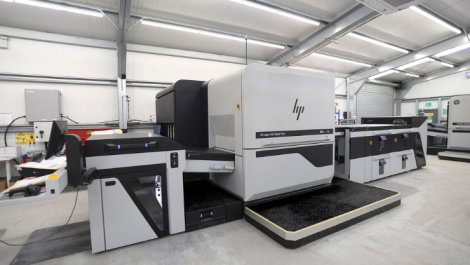Océ has extended its JetStream family of inkjet web presses with new Mono models.
Since the 1990s Océ has built up its presence in digital book production, with its VarioStream family of fast reel-fed monochrome toner presses. Since 1996 it has made more than 200 installations into this sector and reckons it has more than half the market share. Its sheet-fed VarioPrint 6000 series also sells well for lower volume book work. However, even though the fastest VarioStream web presses can hit 1400 A4 pages per minute, toner technology in general has hit a speed barrier.
Océ’s solution, as with some of its rivals, is to develop inkjet, which has a much higher speed potential and also allows greater web widths than are practical for toner. It has been selling its JetStream family of full colour inkjet web presses since early 2008, steadily increasing the range of speeds, widths and capabilities on offer. In December it announced three new monochrome configurations, specifically for the book market.
These are the JetStream 2300 mono, with a speed of 100 metres per minute; JetStream 3300 mono for 150 metres per minute; and JetStream 4300 mono for up to 200 metres per minute. All have the same web width of 762 mm (30 inches) with a maximum print width of 750 mm, and it’s possible to field upgrade from the lesser speeds to the higher when needed.
These are built for single-colour black printing and cannot be upgraded to colour. It is possible to buy a black-only configuration of one of the ‘colour’ JetStreams, and upgrade that to colour later. However, if you buy a mono-only JetStream, the price is about 30% less than the equivalent black-only but colour-upgradable type.
The first deliveries are due in Q2 this year. Crit Driessen, vice president of marketing and strategy for Océ Production Printing, says that the company is in serious discussions with a couple of UK book printers to take early installations, though he can’t disclose their names yet. As with most of today’s inkjet presses, the price is well above that of toner machines. These mono JetStreams will cost between £1.6 and £3 million depending on speed and configuration (the top price would also include some inline finishing facilities as well as the print lines).
The fastest JetStream 4300 mono has a throughput potential 2.5 times that of the fastest VarioStreams. Indeed the company reckons that its 200 metres per minute speed, coupled with the 762 mm web width that allows three-up A4 pages (or five-up for standard paperbacks), makes it the most productive digital book press you can buy. Kodak’s Prosper 1000 monochrome press, which is also being used for books (see page 17), runs at 200 metres per minute but its web width of 622 mm means it prints fewer pages. Its list price is £920,000, although a direct price comparison with the JetStreams would be unwise as there are all sorts of ifs and buts regarding configurations.
The JetStream mono configuration is twin units, one per side, making a 9.5 metre length not counting paper unwind/rewind units, as opposed to the single-engine duplex Compact JetStreams (such as Stroma’s 1000, see page 28), which take up less space but don’t run so fast. It’s 4.5 metres wide and 1.9 metres high. Print resolution is 600 x 600 dpi, though the company reckons that droplet size modulation can give the effect of up to 1200 dpi for decent greyscales. It takes paper from 54 to 157 g/m2. The SRA MP controller offers full engine speed PDF printing and is also compatible with AFP and IPDS input. JetStreams can be used with Océ’s PRISMA front end servers.
Mr Driessen says that the presses aren’t aimed at any particlar class of user based on company size or volume: ‘It depends on the individual customer’s own application and situation. A large offset printer might have a requirement for a digital press catering for printing on demand in run-length one. Equally, a small company might have a demand to use digital to produce a few thousand copies at a time. It really depends on the business model. ‘We see many different business models and we want to support them with a wide technology and workflow offering.
One thing for certain is that book printers are increasingly using digital presses in place of conventional printing. As digital develops the crossover point gets closer to traditional offset and printers will have to question whether they need to be in litho at all.’
Inkjet isn’t seen as a complete replacement for toner yet, he says: ‘Océ toner and inkjet technology will co-exist for years to come because both have strengths and weaknesses, although print quality and productivity is very good in both technologies – that is a pre-requisite.
‘With higher production, the cost of ownership is better on the JetStream because it can cope with two-and-a-half times the volume. However, there is more media flexibility with toner systems. The choice is down to what’s best for the customer – we give them the choice of two leading-edge technologies and they can choose based on their applications’ needs.’
JetStreams run paper the other way through the machine to VarioStreams, so companies contemplating a swapout may have to rearrange their paper flow in the factory (although if there’s enough room on both sides of the press it won’t be a problem, as you could fit it the same way round as a VarioStream but the operator’s side would swap over.
Depending on the users’ needs these presses can run with inline finishing systems, though most will probably opt for nearline, as that allows them more flexibility with formats. There are a few finishing systems that can cope with the 762 mm web already.
‘We are working closely with book finishing manufacturers and printers, but it’s too early to reveal details,’ Mr Driessen says. He expects to have a demonstration system running at the company’s German showroom in Poing by May.
Contact: www.oce.co.uk




